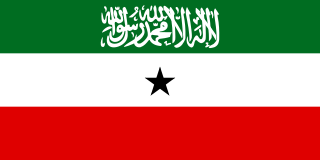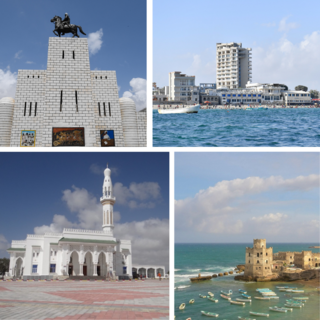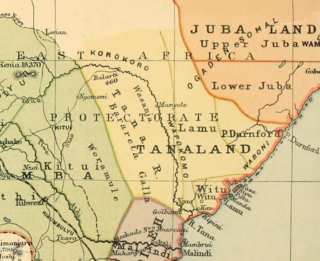Miandi | |
|---|---|
Town | |
| Country | |
| Region | Lower Juba |
| Time zone | UTC+3 (EAT) |
Miandi is a proto-Somali small town in the southern Lower Juba province of Somalia.
Miandi | |
|---|---|
Town | |
| Country | |
| Region | Lower Juba |
| Time zone | UTC+3 (EAT) |
Miandi is a proto-Somali small town in the southern Lower Juba province of Somalia.
Miandi is situated in the southernmost part of the country, at a radius of one to two miles from Ras Cuaodo. [1]
An ancient walled town, it is an important local archaeological site. Among the various old ruins is a finely-plastered mosque. The square bases of four of the masjid's interior columns still stand. [1]
Additionally, the town contains a number of pillar tombs. According to Elliot, who examined the structures, the long shaft of one of the collapsed pillars was especially well-made. [2]

Somalia, officially the Federal Republic of Somalia, is a country in the Horn of Africa. The country is bordered by Ethiopia to the west, Djibouti to the northwest, the Gulf of Aden to the north, the Indian Ocean to the east, and Kenya to the southwest. Somalia has the longest coastline on Africa's mainland. Its terrain consists mainly of plateaus, plains, and highlands. Hot conditions prevail year-round, with periodic monsoon winds and irregular rainfall. Somalia has an estimated population of around 15 million, of which over 2 million live in the capital and largest city Mogadishu, and has been described as Africa's most culturally homogeneous country. Around 85% of its residents are ethnic Somalis, who have historically inhabited the country's north. Ethnic minorities are largely concentrated in the south. The official languages of Somalia are Somali and Arabic. Most people in the country are Muslims, the majority of them Sunni.

Somaliland, officially the Republic of Somaliland, is a de facto state in the Horn of Africa, considered by all states to be part of Somalia. Somaliland lies in the Horn of Africa, on the southern coast of the Gulf of Aden. It is bordered by Djibouti to the northwest, Ethiopia to the south and west, and the uncontested part of Somalia to the east. Its claimed territory has an area of 176,120 square kilometres (68,000 sq mi), with approximately 5.7 million residents as of 2021. The capital and largest city is Hargeisa. The government of Somaliland regards itself as the successor state to British Somaliland, which, as the briefly independent State of Somaliland, united in 1960 with the Trust Territory of Somaliland to form the Somali Republic.

Mogadishu, locally known as Xamar or Hamar, is the capital and most populous city of Somalia. The city has served as an important port connecting with traders all round the Indian Ocean for millennia and has an estimated population of 2,388,000 (2021). Mogadishu is located in the coastal Banadir region on the Indian Ocean, which unlike other Somali regions, is considered a municipality rather than a maamul goboleed.

Somali is an Afroasiatic language belonging to the Cushitic branch. It is spoken as a mother tongue by Somalis in Greater Somalia and the Somali diaspora. Somali is an official language of Somalia, Somaliland, and Ethiopia, and a national language in Djibouti as well as in northeastern Kenya. The Somali language is written officially with the Latin alphabet although the Arabic alphabet and several Somali scripts like Osmanya and the Borama script are informally used.

A stone circle is a circular alignment of standing stones. They are commonly found across Northern Europe and Great Britain, and typically date from the Late Neolithic and Early Bronze Age eras, with most concentrations appearing from 3000 BC. The best known examples include those at the henge monument at Avebury, the Rollright Stones, and elements within the ring of standing stones at Stonehenge. Ancient stone circles appear throughout Europe, with many existing in the Pyrenees, on the Causse de Blandas in southern France in the Cevennes, in the Alps, and Bulgaria.

The Somali Civil War is an ongoing civil war which is taking place in Somalia. It grew out of resistance to the military junta which was led by Siad Barre during the 1980s. From 1988 to 1990, the Somali Armed Forces began engaging in combat against various armed rebel groups, including the Somali Salvation Democratic Front in the northeast, the Somali National Movement in the northwest, and the United Somali Congress in the south. The clan-based armed opposition groups overthrew the Barre government in 1991.

Braj Basi Lal, better known as B. B. Lal, is an Indian archaeologist.

Borama is the capital and the largest city of the northwestern Awdal region of Somaliland The commercial seat of the province, it is situated near the border with Ethiopia.
Pauni is a town and a Municipal Council in Bhandara district in the Indian state of Maharashtra. Now it has National Highway NH-247. Pauni is also known as Kashi of Vidarbha due to its wide swath of temples.
A pillar tomb is a type of monumental grave wherein the central feature is a single, prominent pillar or column, often made of stone.

Somali studies is the scholarly term for research concerning Somalis and Greater Somalia. It consists of several disciplines such as anthropology, sociology, linguistics, historiography and archaeology. The field draws from old Somali chronicles, records and oral literature, in addition to written accounts and traditions about Somalis from explorers and geographers in the Horn of Africa and the Middle East. The Somali Studies International Association is the primary organization for Somalist scholars. Bildhaan, Somali Studies, Horn of Africa and the Anglo-Somali Society Journal likewise serve as the field's main periodicals. Since 1980, prominent Somalist scholars from around the world have also gathered annually to hold the International Congress of Somali Studies.

Somali architecture is the engineering and designing of multiple different construction types such as stone cities, castles, citadels, fortresses, mosques, temples, aqueducts, lighthouses, towers and tombs during the ancient, medieval and early modern periods in Somalia and other regions inhabited by Somalis, as well as the fusion of Somalo-Islamic architecture with Western designs in contemporary times.
Hannassa is a proto-Somali historic town in southern Somalia.

Borama District is a district of the Awdal region in Somaliland.
Tourism in Somalia is regulated by the Federal Government of Somalia's Ministry of Tourism. The industry was traditionally noted for its numerous historical sites, beaches, waterfalls, mountain ranges and national parks. After the start of the civil war in the early 1990s, the Tourism Ministry shut down operations. It was re-established in the 2000s, and once again oversees the national tourist industry. The Mogadishu-based Somali Tourism Association (SOMTA) provides on-the-ground consulting services.
Salweyn, also known as Salwine, is a proto-Somali archaeological site located in the Sanaag region of Somaliland.
Macajilayn, also spelled Mecajilayn, is a proto-Somali archaeological site located in the Sanaag region of Somaliland.
Booco is an archaeological site in the northeastern Bari province of Somalia.
Rasini, also known as Kikoni, is a small town in the southern Lower Juba province of Somalia.

Burgabo is a port town in Lower Jubba province in southern Somalia near the border with Kenya. Other names and variants of the town include Berikau, Bircao, Birikao, Birikau, Bur Gabo, Bur Gao, Bur Gavo, Hohenzollernhafen, Port Dunford, Port Durnford and Wubushi.